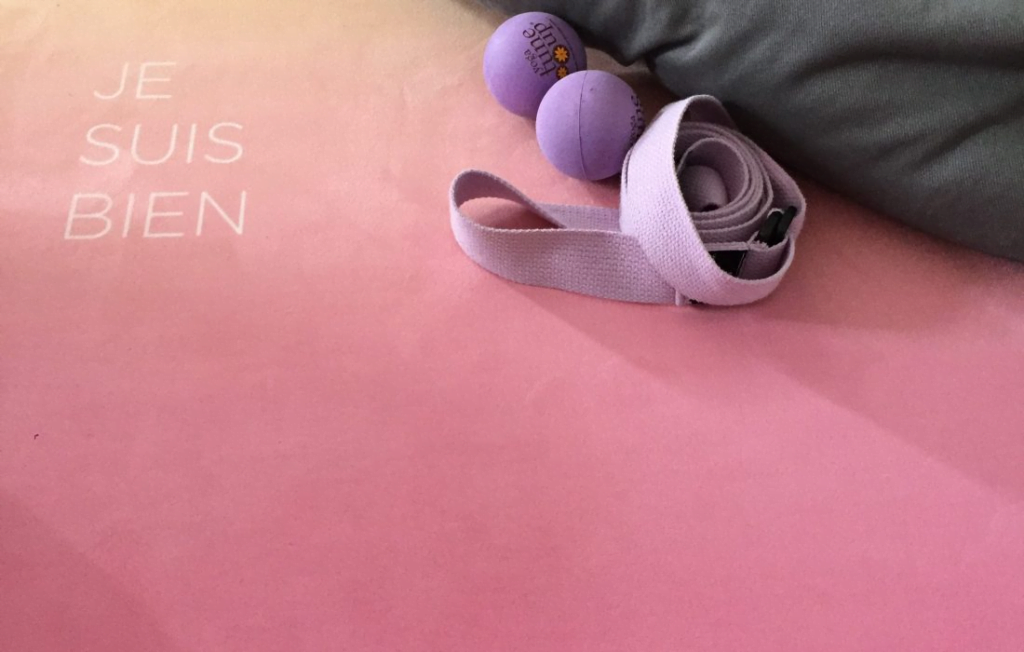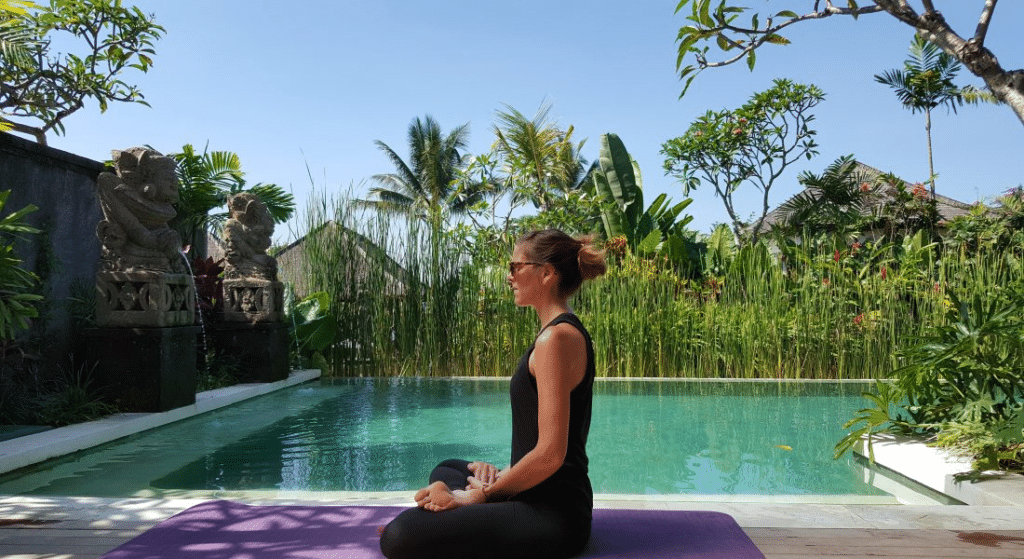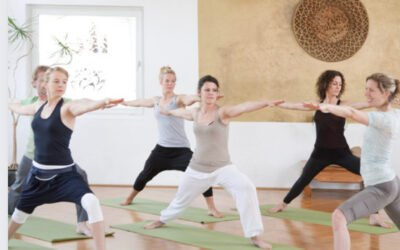Why do yoga and endometriosis go hand in hand when you suffer from this gynecological disease?
I like to say that yoga brings us what we need. This is also true when you have endometriosis, adenomyosis (internal endometriosis) or suffer from painful periods.
Yoga is a wonderful complement to traditional hormonal and drug treatments or traditional medicines such as Chinese medicine (acupuncture), naturopathy or Ayurveda to relieve your pain and symptoms of natural endometriosis, improve your quality of life and (re)live your life. A recent scientific study has demonstrated this. I have experienced it personally and observe it daily with the women I have the chance to accompany by transmitting them individualized tools from yoga and ayurveda.
Yoga and endometriosis: what does the science says
A recent scientific study1 on endometriosis reveals that yoga reduces pain and improves quality of life.
In Brazil, a study was conducted on the practice of yoga to reduce pain caused by endometriosis. The purpose of this study was to evaluate chronic pelvic pain, menstrual cycles and quality of life.
The results of this study on yoga and
endometriosis
The study shows that yoga is an effective practice to reduce the chronic pelvic pain experienced daily in a woman who has been diagnosed with endometriosis.
The pain decreased in the group of yoga practitioners. This reduction was even statistically significant.
The quality of life also improved considerably.
The practice of yoga, in its entirety (not only postures), therefore allows you to have a safe and effective tool to improve your quality of life independently.
We take out his carpet!
The benefits of yoga for endometriosis
YOGA tools and lifestyle help us physically, mentally and emotionally. And also in our care and well-being journey as for example:
– promote and support hormonal balance, which is essential because endometriosis is a hormone-dependent disease
– reduce inflammation but we know that endometriosis is an inflammatory disease
– reduce oxidative stress that triggers an inflammatory response
– a harmony of your energy and vitality
– align and balance your cycle
– relieve pain
– understand, accept and manage your emotions (sometimes it’s physiological and normal
– adopt a yogic lifestyle in a sustainable way
– more clarity. We follow the intuition that guides us towards the best choices for ourselves in our care path
– more lightness, serenity and self-confidence
– holistic and sustainable well-being
-…

Yoga, some recommendations when you suffer from endometriosis
I often see people who practice yoga by postures only and do not see and do not benefit from all the opportunities offered by yoga as a whole. Yoga is an art of living, a personal quest, a path on which each of us is at a different time. However, the yoga of endometriosis requires some consideration.
Adapt your yoga practice according to your menstrual cycle
I also think that some forms of yoga, such as hatha yoga, ashtanga or vinyasa, may be too intense for some women at certain periods of their menstrual cycle at the risk of disrupting it and possibly triggering or aggravating pain.
Some dynamic and “heated” yoga postures should also be avoided at certain periods of the cycle, especially during the pre-menstrual phase and menstruation.
Adapt the tools of yoga to yourself
It is also important to take into account your own terrain, your symptoms and pains, your rhythm and lifestyle, your imbalances, your chakras, the stage in your menstrual cycle, your dosha (according to Ayurveda), you what :).
You are a whole
Considering your person on all physical, mental, emotional, energetic, spiritual, holistic levels is essential to relieve your pain, improve your quality of life and feel a lasting holistic well-being, body, head and heart.
Practice all the yoga tools at our disposal
Yamas and Niyamas
These are principles of yogic life. These are the foundations of yoga.
NIYAMAS are personal principles or observances and YAMAS are principles of relationship to others and their environment.
Cultivating them is a subtle work and a relationship to oneself and our environment. It is subtle and invisible unlike yoga postures that are visible.
The YAMAS
The Yamas are the moral and ethical foundations. There are 5 observances or principles that are suggested to us to maintain health, well-being and balance and that can be applied in our daily lives, our thoughts, our actions, our words. This will help build a better world and it starts with us. It is to become aware of what surrounds us, respect it and align with this environment. It is knowing how to be with others and your environment.
These 5 observances are:
- Ahimsa or non-violence. Be kind to everyone, but also to yourself.
- Satya or tell the truth. Be honest in your words, your thoughts, your actions.
- Asteya or not to steal. It can be objects, but also another person’s time, or anything that has not been offered to us.
- Brahmacarya or the control of the senses. Be able to use your energy with wisdom and moderation.
- Aparigraha or non-possessivity. Know how to let go of life, events and situations in life and accept the instability of things, thoughts, situations. Everything is cyclical. Nothing remains.
The NIYAMAS
NIYAMAS are suggestions or personal observances to reach your full potential, have and maintain a good quality of life with kindness to yourself. It’s being yourself and becoming aware of yourself.
- Shaucha or purity. Know how to purify your heart, mind and body.
- Santosha or contentment. It is acceptance and satisfaction in any experience you live.
- Tapas or rigor. Be able to direct your energy and practice in all circumstances. It’s keeping a certain discipline.
- Svadhyaya or the search for your true nature. It’s self-knowledge. The desire to get to know each other better through practice or work on oneself.
- Ishwarapranidhana or abandonment to a higher power. You are united with your environment, nature, others,… All this forms a whole. It is to realize that you are part of this whole, and that everything is connected and interconnected.
Pranayama
Pranayama are breathing exercises to control or improve prana, our vital force. In Chinese medicine, it is called Xi. We can use pranayama to increase energy in the body or to calm the nervous system.
When we feel pain, the natural response is to contract, to activate our stress response system with the famous “Fight or fly” or “struggle or flight” system, i.e. to an overactivity of the sympathetic nervous system. With conscious breathing techniques, we can influence heart rate, blood pressure and muscle relaxation in response to pain, release muscle and emotional tension.
Asana
Asanas are the physical postures used to balance energy in your body and prepare the body and mind for meditation. Women with endometriosis will have different physical abilities at different times of the month and day. The postures I teach and practice make it possible to promote soft and fluid mobility of the pelvis and pelvic region in particular, to release tensions and blockages in all subtlety and without ever forcing.

Dhyana
Dhyana is a meditation or mindfulness attention exercises. This allows us to stay in the present, not to be afraid of what can happen. Like the fear of having pain during your next period because as long as you don’t really live it in the moment, you only imagine and suppose by creating unnecessary tensions). Or to stay on what a doctor or a member of our entourage told us. There too, we create internal tensions and stress that we could well do without.
The mantras
The mantra is at the heart of yoga practice and acts as a support for healing by improving the circulation of vital energy and allowing you to let go in particular. Their sounds emit vibrations.
The monsters have a healing power and bring real well-being. There are many monsters that will be used according to your need. Each will also give different to one or the other mantra. It is necessary to find his. This can also evolve according to your needs and your evolution.
You certainly know or have heard the OM or AUM mantra. It is certainly the best known. It is a universal sound, it is considered the primordial sound, it contains the vibration of the universe, it is used as a prefix and sometimes a suffix to mantras.
I practice many monsters with my students and some are particularly powerful and effective for the female sphere.
The mudras
Mudra means in Sanskrit a gesture, a seal or a symbol.
You have certainly already seen some practice on photos by seeing people meditate for example. This mudra is called Gyan or Jnana mudra and Chin mudra.
According to the yogic tradition, we find at the fingertips and in the hands (as under the feet in reflexology) points that refer to certain parts or functions of the body. When these points are activated and stimulated, they in turn activate regions or systems of the body. We then rebalance the energy and at the same time we feed the area concerned, Working with our fingers we can harmonize our physical state, control our emotions, increase concentration, and finally be in perfect harmony with ourselves and others.
You can perform mudras in yoga postures, but also in a tailor, when you meditate, in the queue, in a doctor’s waiting room,… I like to practice them by associating them with their mantra (sound).
A sequence of yoga, lifestyle and the tools of yoga and ayurveda
To relieve his pain and symptoms of endometriosis naturally
Yoga is a wonderful way to relieve your endometriosis pain naturally, but also your symptoms (emotions, back pain, sciatica, digestive ailments, difficulty becoming a mother, reconnecting with yourself…) and to improve your quality of life sustainably.
To (re)live your life with the disease
Equipped with this wonderful practice of yoga and benefiting from all its art of living, you are then more serene and confident in your ability to go through what happens to you, a pain attack, emotions, stress, a news or dialogue with a doctor…
Learn to be an actor of your health and well-being by activating your inner resources and abilities
What helped me and always helps me thanks to yoga to live with the disease and embrace my life (almost without remembering that it is there):
- yoga or asanas postures
- meditation
- Breathwork and pranayama
- the rest
- yoga therapy
- the mudras
- the mantras
- Energy work
- the harmonization and rebalancing of my chakras
- positive thinking and personal development
- natural care such as plants, essential oils, clay,…
- physical, mental, emotional, environmental detox
- the evacuation of toxins and physical, mental, emotional pollutants (emotional release)
- yogic, anti-inflammatory, alkalizing and ayurvedic diet
- Ayurveda
- respect for my natural rhythm according to Ayurveda, chronobiology, my own physiology
- alignment with my menstrual cycle and female rhythm
- …
- And above all, the fact of considering my whole being on a physical, mental, emotional, energetic level.
Practice and everything will come – Patthabi Jois
Regular practice is super important.
We can train for our well-being, to set up small routines, small tools that will help us to get better, to feel good.
The first thing to do is to practice, a little regularly. A few minutes a day are enough. You just have to know how to breathe to practice yoga, so we can all practice. It’s also nice to be able to share, exchange and feel supported.
Yoga is transforming our lives. In any case, he transformed mine on many levels…
I myself have developed my own holistic method blending the wisdom of yoga and traditional medicine (naturopathy, ayurveda, TCM) with the knowledge of modern science. I am honored to share the lifestyle and tools that could help you and / or your students and patients in personnalized coaching, workshops or yoga therapeutic teacher training. Find out more, here.
My mission is to equip women with the knowledge, tools and own practice so they can draw at every moment when they need it.




0 Comments